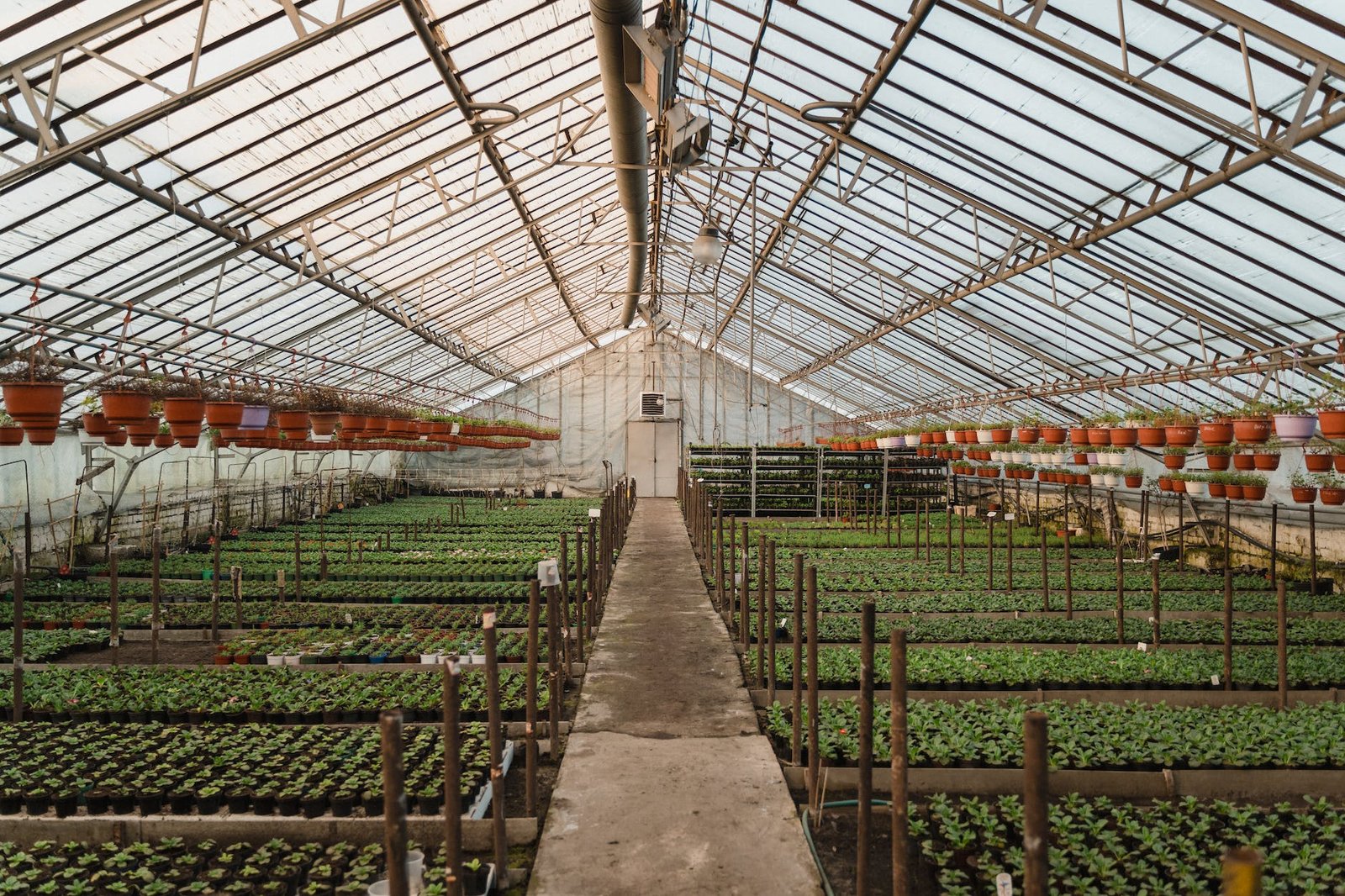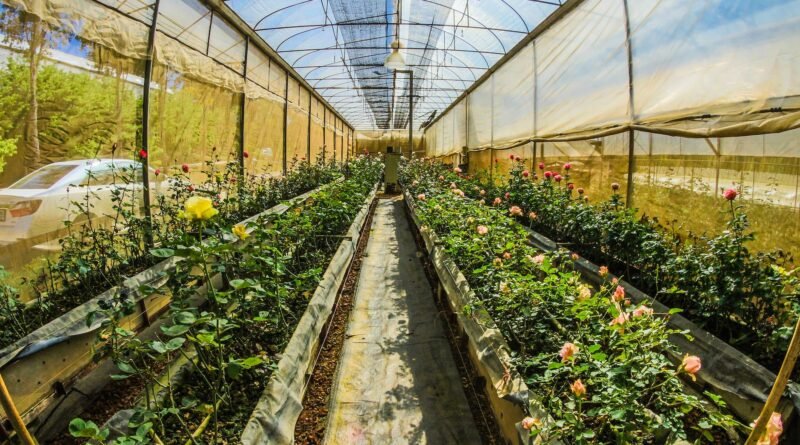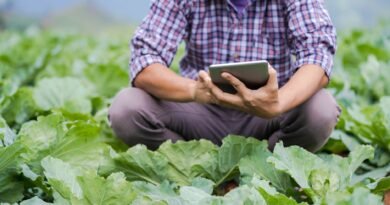Greenhouse Farming: Overcoming Weather Limitations

Many farmers are building greenhouse structures to grow their crops and even rear animals as a result of the more unpredictable weather. New technology in greenhouse structures and controlled environment growth techniques provide a scalable answer to sustainable food production when integrated with farm management software for extremely efficient operations. irrespective of what the weather does.
The content of this guide is intended to help farm businesses manage and scale their agricultural production while limiting the effects of the weather by employing covered greenhouse structures.
How Does the Weather Impact Agriculture?
Agricultural productivity is negatively impacted by extreme weather conditions and even minor climatic changes.
The weather disasters that have the biggest immediate effects are floods and droughts, which often result in output losses. However, there are several indirect or less noticeable ways that weather influences farming.
For example, while a persistently rainy and cold spring may not cause floods, it nonetheless inhibits a farmer from planting his or her crops when they would typically be done in the spring. Or, moist circumstances can stress young plants and adversely impact their crucial early development, making them more vulnerable to disease outbreaks and insect predation. A crop may be destroyed by early-fall cold snaps before it reaches maturity, while crop development may be negatively impacted by excessive heat throughout the growing season.
Not only crops, either. Extreme weather conditions have an impact on livestock output as well; drought has a particularly negative impact on the cattle business since it severely limits the development of grasses and forages for pasture grazing. However, even tiny animals, such as chickens raised for their meat and eggs, are vulnerable to temperature fluctuations.
The capacity to regulate the greenhouse environment and greenhouse temperatures to support the development of high-quality crops, even on a year-round cycle, is the major benefit of greenhouse farming.
Greenhouse Farming, sustainability, and Climate Change
Although farming has always been impacted by extreme weather, the danger to global food security posed by global warming brought on by rising levels of greenhouse gases in our atmosphere is increasing the frequency and severity of adverse weather occurrences.
The Earth’s average temperature has increased by 1.1 degrees Celsius since pre-industrial times, according to the United Nations. Even while that might not seem like much, rising air temperatures alter typical weather patterns, leading to more disastrous heat waves, extremely high precipitation amounts, and other weather-related catastrophes, such as rising sea levels due to glacier melt. These incidents make it more difficult for farmers to cultivate crops the conventional way.
At the same time, the issue of climate change is exacerbated by agricultural output and farming methods. Traditional agricultural methods contribute to the atmosphere’s emission of greenhouse gases including nitrous oxide and methane as well as carbon dioxide. The food supply chain contributes between one-third and one-fourth of the planet’s annual greenhouse gas emissions. A more sustainable food supply chain that supports healthy ecosystems and surroundings is now being demanded by consumers and food supply corporations.
In essence, farmers and growers are both harmed by the issues brought on by climate change and contribute to the cause of the problem in the first place.
One approach to addressing the issue of climate change is greenhouse farming.
In contrast to conventional agricultural production, greenhouse structures can reduce extreme temperatures while supporting food production in areas where it was previously impractical. This lowers transportation-related carbon emissions, lessens the impact of supply chain shocks, and conserves water and nutrients. Additionally, producers can produce more food in a smaller greenhouse area compared to outdoor production models, which eases the pressure to cultivate forests and prairies and preserve those ecosystems as vital carbon sinks.
Agriculture in a Controlled Environment vs. Farming in a Greenhouse Both the words “greenhouse farming” and “controlled environment agriculture” are synonymous. They differ significantly in several important ways, though. Temperature, humidity, sunshine, water, nutrition, and even the planting medium (also known as soil) are all under the control of CEA. A CEA grow takes place totally inside, usually in a warehouse, using a soilless growing technique (commonly hydroponic), and makes use of LED lighting to mimic sunlight and stimulate photosynthesis. However, a significant drawback of CEA is the high cost of power required to run the LED lighting system.
As a form of CEA, greenhouses make use of natural sunlight by covering the building with a transparent material, such as glass, fiberglass, vinyl polyethylene, or polycarbonate. All the elements present in a CEA grow may be utilized in a greenhouse farming operation, depending on the type of greenhouse. Even some hydroponic farmers run their businesses from greenhouses. The main benefit of greenhouses is their capacity to use natural sunlight as their main source of light in the greenhouse environment, which allows them to balance their power expenses. Nevertheless, some greenhouse buildings also have LED lights installed to supplement natural sunlight during seasons when it is scarce.
Types of Greenhouse Farming Various types of structures can be used for greenhouse farming, depending on the objectives and requirements of the farming activities. They differ according to the construction method, the material used to cover them, and the system. Simple greenhouse constructions are inexpensive to build, extending the growing season and increasing food production for tiny, starting farmers and smallholder farms in underdeveloped countries. Depending on the size and materials required, simple greenhouse structures can be erected for as little as a few thousand dollars.
On the other end of the spectrum are sophisticated, controlled greenhouse structures that can be scaled out across several locations and maintained using farm management software. Commercial greenhouses may cost millions of dollars to build and are frequently outfitted with cutting-edge management technologies, such as automated benching systems for moving potted plants, lighting, drip watering, and fertigation.
Polytunnels and hoop house
Greenhouses constructed on hoops are referred to as hoop houses or polytunnels. Any suitable materials can be used to construct the hoop frame. In areas of the world where bamboo is widely available, hoop homes have historically been constructed using this material. Metal or PVC pipework is also often employed. Hoop homes must be covered with a flexible material, usually a 6-mil polyethylene plastic that resists UV deterioration due to the hoop structure. The plastic may persist for many years, but ultimately it will need to be replaced.
Hoop houses may be constructed at a fair price, be used as temporary construction for a season, or even be made to be movable. A common design feature of hoop houses is the ability to raise and lower the side walls, allowing for natural ventilation that lowers temperatures and humidity. Hoop houses are common kinds of structures with lower budgets and easier management objectives due to their affordability, adaptability, and ease of construction. To fulfill the demands of commercial enterprises, hoop house construction may be modified with high-tech advancements, including sophisticated HVAC, irrigation, and nutrient management systems.
Glass and polycarbonate houses
Because polycarbonate and glass are solid building materials, greenhouses made of these materials are constructed on flat or angled roofs rather than hoop frames. Glass and polycarbonate are more expensive to install but last longer than hoop buildings with plastic coverings. They are more frequently observed in industrial greenhouse houses. A polycarbonate or glass home can have a variety of frame designs, such as gable, flat arch, and gothic. Sometimes a greenhouse’s side walls are made of polycarbonate, while its top is made of polyethylene.
Screen houses and shade structures
Structures that provide shade are used to lower temperatures and reduce how much sunlight crops get. Fast-growing greens that are sensitive to hot temperatures, like lettuce or young salad greens, benefit from shade structures. A woven textile used to cover shade structures limits sunlight. The material may be constructed over hoop frames or frames with more jagged edges since it doesn’t rip as easily as plastic does. Some greenhouse owners will cover and uncover an existing greenhouse structure with shade cloth. By doing this, they can change their greenhouse from one that captures sunlight to raise temperatures in the winter to one that shades sunlight to lower temperatures in the summer.
Additionally, in small animal husbandry, shade structures shield poultry like hens and turkeys from heat waves. The idea behind screen houses is the same as that behind shade houses, with the exception that a finely woven mesh screen is used to cover them to keep out pests. In locations with severe pest issues or with high-value crops susceptible to pest pressure (like cannabis), screen houses are beneficial.
Greenhouse farming: advantages and disadvantages
There are advantages and disadvantages to greenhouse farming that need to be taken into account.
Greenhouse farming advantages
- Weather extremes, including windstorms, droughts, frigid spells, and heat waves, are lessened.
- Extend agricultural production seasonality.
- Crops with higher yields and consistent agricultural output.
- Easier pest control and an effective defense against damaging animals like deer or rabbits.
- Encourages the growth of valuable crops and difficult-to-find plant types.
- It is possible to use less fertilizer, pesticides, and water.
- Maximum revenue in a compact area.
Disadvantages of Greenhouse
- Agriculture production expenses are high.
- High initial outlay for the construction of the building.
- Not by natural pollination.
- Maybe requiring special authorization.
- High disease pressure is possible.
- It calls for a high degree of expertise.
- Only crops of great value are produced.
What Components Are Involved in Greenhouse Farming?
Consider your company’s objectives and all the possible factors involved in setting up, managing, and operating a successful greenhouse farming operation before deciding to pursue greenhouse farming.
Take into account all of the fundamental aspects of greenhouse farming and how they connect to your company’s objectives first. These components consist of:
- The shape of the structure
- Lifespan and life-cycle of the structure
- Cover material
- Size of the farm
- Level of farm management technology
Review the factors that will affect your greenhouse structure once you have determined your main business objectives for your greenhouse farming firm. These elements consist of:
- The amount of sunlight
- The amount of natural ventilation
- The size of the farm
- Condensation run-off
- Efficiency of materials
- Costs
Farm Management Software and Greenhouse Farming
Farm management software (FMS) goes hand-in-hand with commercial greenhouse operations, especially for farm enterprises managing multiple greenhouse operations in different locations.
The farm management software system jointly manages dislocated farms, connects inventory from warehouses and staff work orders, and connects the rest of the agri-supply chain with the greenhouse production center. It can also support the automation of greenhouse functions, like irrigation, HVAC systems, and lighting controls.




I think that is among the so much significant info for me. And i am glad studying your article. However want to remark on few general things, The website style is great, the articles is in reality excellent : D. Excellent task, cheers
Thank you for your appreciation and love.
I do believe all of the concepts you have introduced for your post. They are very convincing and can certainly work. Nonetheless, the posts are too short for starters. May just you please extend them a bit from next time? Thank you for the post.
Thanks for the appreciation.
I do believe all of the concepts you’ve introduced in your post. They’re really convincing and will certainly work. Nonetheless, the posts are very brief for newbies. May just you please extend them a bit from subsequent time? Thanks for the post.
Wow, marvelous blog layout! How long have you been blogging for? you make blogging look easy. The overall look of your web site is wonderful, let alone the content!